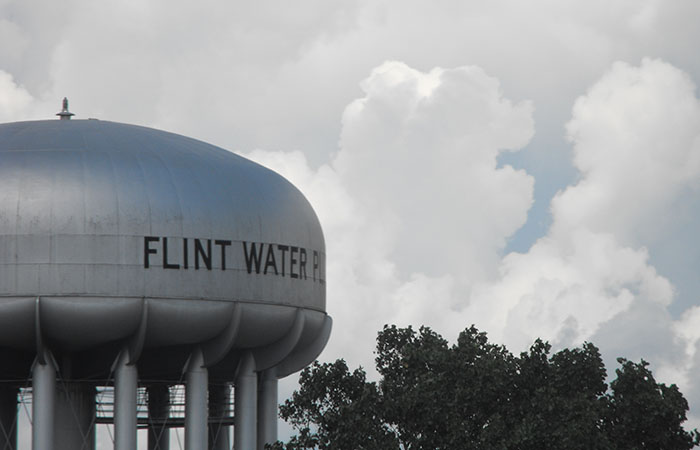The Long-Term Effects of Lead: Flint and Beyond
Economist Joseph Ferrie investigates the effects of lead in drinking water
Get all our news

As the water crisis continues in Flint, Michigan, research shows the deleterious effects of lead in drinking water.
Long before news of Flint’s water crisis broke, economist and IPR associate Joseph Ferrie was examining how lead affects human cognition and outcomes.
Water-borne lead is not just highly toxic—it is one of the greatest environmental hazards from the early 20th century onward, according to Ferrie.
“It’s insidious,” he said. “It’s not something that you would notice, it’s not something that you can breathe. It’s in the water that we drink.”
Starker still are the research findings, Ferrie’s among them, that the effects of lead are far more pervasive and long lasting than initially thought. He surmises that lead has likely affected millions of Americans since the 1900s, and he emphasizes that “there is no safe level of lead exposure,” especially when it comes to kids.
How Lead Seeps into Drinking Water
It has been several decades since lead was officially removed from house paint (1978) and gasoline (1996)—though lead paint in older homes and apartments continues to pose dangers—but the problem of lead in drinking water is “as true now as it was at the beginning of the 20th century,” Ferrie continued.

The problem, he explained, is not actually with the water itself, which is mostly clean. It is the 10–20 yards your drinking water travels in service lines from your municipal water supply to your home’s taps, and any lead it might encounter on the way—either through the pipes, solder, or brass fixtures.
Most U.S. municipal water systems were built in the 19th century, a time when lead service pipes were extensively used. Starting in the 1960s, however, researchers began to show the negative effects of lead. Though the Environmental Protection Agency (EPA) eventually banned lead piping in new construction in 1986, it still remains in structures built before then.
“Nobody really knows how much lead piping there still is out there,” Ferrie said.
He estimates that around 6.4 million U.S. homes still have lead service pipes, and 81 million still have lead solder and lead-bearing brass fixtures. Replacing the remaining service pipes for an entire city is costly—estimates run around $60 million just for Flint—and few cities have done it.
It’s Not Just Flint
Flint’s problem, Ferrie recounts, was its switch from getting treated water from Lake Huron, to untreated water from the Flint River, and then to untreated Lake Huron water.
If the water passing through a lead pipe is not at the optimal pH of 7.5, it causes the pipe to leach lead particles. Since Flint’s untreated water was no longer at an ideal pH, the city’s lead service pipes started leaching.
So, how many cities are prone to Flint-like crises? Ferrie says there is no way to accurately know, as states are not mandated to report incidents of water-borne lead concentration to the EPA. Most municipalities report on their water quality by measuring their water before it ever reaches the last few yards of piping leading into a home.
It happened in Flint and it can, and does, happen, elsewhere: Ferrie points to cities that tend to have naturally acidic water (below a pH of 7.5), such as those in New England states. And the problem stretches beyond U.S. borders. Ferrie estimates that more than half of all dwellings in the European Union have lead piping, putting hundreds of millions of people at risk.
How Does Lead Affect Human Development?
Ferrie has spent 20 years stitching together an incredibly detailed dataset, currently encompassing 1.2 million Americans. He and his colleagues drew information on individuals from Social Security, census, army, and death records, as well as on water systems in more than 300 U.S. cities—all to trace how lead in drinking water affects human development.
The effects are “shockingly large,” he said.
He explained that growing up in city where the water pH is at an optimal 7.5 could result in a lifetime income boost of 10–15 percent for an adult city dweller in 1940 when compared with an identical adult living where the pH was 6.5. This is because a water pH above or below 7.5 results in lead leaching into drinking water, thus increasing the potential for cognitive impairment.
When added up across America’s entire population over the 20th century, “It’s consistently costing the American economy a lot of money,” he calculated.
For Ferrie’s first study on the topic, published in Economics and Human Biology in 2012, he and his colleagues used scores from the Army General Classification Test, an intelligence test, as a proxy for IQ. The researchers then traced where the soldiers grew up through census records, linking those to their hometown water pH. Those with lower army test scores were consistently from cities with lead service lines and a water pH outside the optimal range, meaning they were exposed to more lead as children.
The second project, currently underway, uses the same dataset, is showing how the after-effects of lead build-up in humans is much more severe for those who come from poorer, more disadvantaged backgrounds—just like many of those affected in Flint.
A third project is investigating how exposure to lead before the age of 3 might contribute to diseases that typically develop decades later, such as the nongenetic form of Alzheimer’s.
What Can Be Done?
Ferrie outlines two immediate policy prescriptions. The first is for cities to keep their water in an acceptable pH range close to 7.5 through the use of chemical additives, such as lime and soda-ash.
The second is that policymakers should launch early childhood interventions if blood tests reveal elevated levels of lead in children under the age of 3. This could be something akin to an intensive Head Start program, and should be done as quickly as possible to remediate the toxin’s damage.
His own research is pointing to how children from wealthier, advantaged backgrounds can completely overcome most of the effects of elevated lead levels, probably due to such intense and early interventions, whereas their poorer, disadvantaged peers do not. It is not yet clear why, he says, but laboratory studies of rats have shown that over time cognitive stimulation can greatly diminish the dire effects of lead exposure.
“We should concentrate those dollars on kids under 3,” he said. Otherwise, affected children start off behind in school and are unlikely to catch up academically once they have fallen behind.
Addressing the problem will involve a challenging, perhaps insurmountable, first step, Ferrie said: Cities would have to individually assess each household’s service pipes. So he suggests that individuals check their home’s service pipes at the point where they connect to their home’s shut-off valve by scratching them with a coin or key. If that reveals a somewhat soft, gray metal, then it’s likely lead, and “you need to think about doing something with your pipe,” Ferrie said.
For those who think water filters are the answer, Ferries acknowledges they can help but will not filter out all of the lead. A temporary fix might involve exactly what Ferrie and Flint residents are doing already—drinking bottled water.
Related article:
Ferrie, J., K. Rolf and W. Troesken. 2012. Cognitive disparities, lead plumbing, and water chemistry: Prior exposure to water-borne lead and intelligence test scores among World War II U.S. Army enlistees. Economics and Human Biology 10(1): 98–111.
Joseph Ferrie is professor of economics and an IPR associate.
Photo credit: Ben Gordon, Flickr
Published: March 2, 2016.